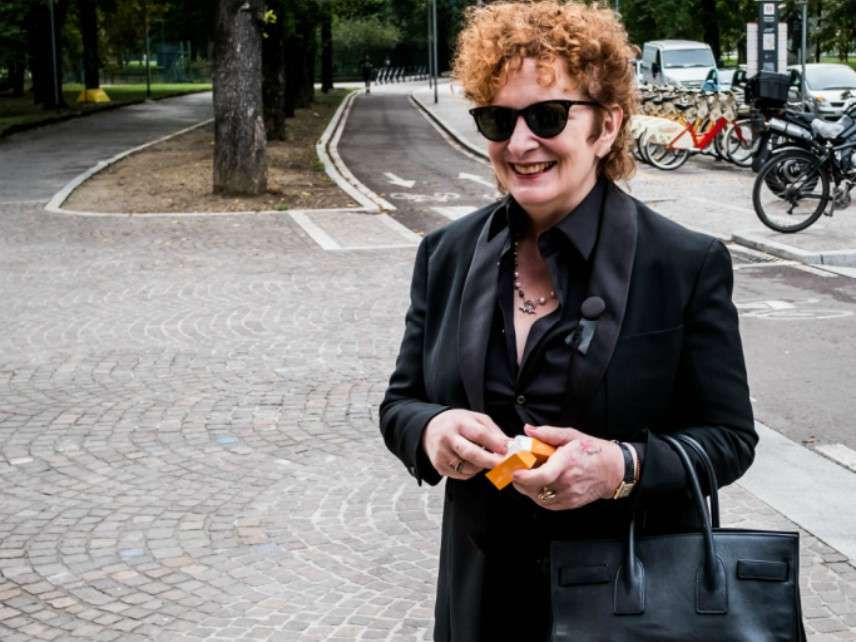Nan Goldin's Back Story Complicates Her Anti-Opioid Narrative of Accidental Addiction
- OurStudio

- Mar 12, 2018
- 3 min read

Nicola Marfisi/Avalon.red/Newscom
Where did people get the mistaken idea that the "opioid crisis" is driven mainly by drug-naive patients who accidentally get addicted while taking narcotics for pain? From stories like this one, in which New York Times reporter Colin Moynihan describes an anti-opioid protest led by photographer Nan Goldin at the Metropolitan Museum of Art on Saturday.
Goldin targeted the museum's Sackler Wing, named for the family that owns Purdue Pharma, the company that makes OxyContin. Moynihan explains that Goldin "started an anti-opioid group called Prescription Addiction Intervention Now, or PAIN, after being addicted to OxyContin from 2014 to 2017." He adds that Goldin "has called withdrawal from OxyContin the darkest experience of her life" and links to his January 22 story describing the roots of her activism.
According to that earlier story, Goldin "began taking the powerful painkiller in 2014 to alleviate wrist pain" caused by tendinitis while living in Berlin. She "quickly became addicted, increasing her intake of pills, seeking out black market sources and finally moving to other drugs." After overdosing on a combination of heroin and fentanyl, Goldin finally decided to go into treatment, and "she has been clean for a year."
As presented by Moynihan, Goldin's story illustrates the overwhelming power of oxycodone, the heedless greed of the companies that make it, and the recklessness of the doctors who prescribe it. Complicating that narrative is the long history of polydrug use and addiction that Moynihan omits from his portrait of Goldin.
"I wanted to get high from a really early age," Goldin told The Guardian's Sean O'Hagan in 2014, the same year OxyContin supposedly put her on a path that ended with a heroin overdose. "I wanted to be a junkie." According to that article, Goldin injected heroin as a teenager. She stopped at the age of 19 but continued to use heroin and cocaine intranasally.
"For years," Goldin said, "I used drugs before I abused them, and I had a good time. People take drugs because they feel good. Especially people who don't have a skin, who are really raw like I was. With heroin, you don't feel any pain. For me, cocaine was worse than smack. It's an evil drug. It sent me to the bottom." In the mid-to-late 1980s, Goldin said, "drugs became my full-time occupation, and about the only people I saw were my dealers."
O'Hagan reported that Goldin "went into rehab" in 1988. "There have been a few relapses since," he wrote, "including a 'major' one in 2000, when she was prescribed strong painkillers for a serious injury to her hand." That was 14 years before the prescription that Goldin says got her hooked on opioids again for three more years, which evidently happened after her interview with O'Hagan. Despite the earlier relapse, Goldin took "strong painkillers" again, aware of the risk that entailed for her. I'm not sure that's Purdue Pharma's fault.
Moynihan does not mention any of this in either of his stories about Goldin's anti-opioid activism. He does note that Goldin is known for her photographs of "people having sex or shooting heroin," which "illustrate[d] the world she inhabited" in the 1980s, when her book The Ballad of Sexual Dependency was published. That is as close as Moynihan gets to acknowledging that Goldin, far from encountering opioids for the first time through a 2014 OxyContin prescription, has used them on and off, including several episodes of addiction, since at least the early 1970s.
According to O'Hagan's profile, Goldin had "a troubled relationship with her parents" and was haunted by the death of her older sister, who killed herself when Goldin was 11. By Goldin's own account, she was "really raw" and found relief from her emotional turmoil in heroin, which she did not come to via OxyContin but first used nearly half a century ago, a quarter of a century before the timed-release pain pill was first marketed.
Goldin's experience with OxyContin, in short, does not tell us much about how the average patient might react to the drug. In fact, the evidence indicates that people who take prescription opioids for pain rarely respond the way Goldin did. When they do, they are likely to have a background similar to Goldin's, including prior substance abuse and psychological trauma. These are important things to know if you are trying to assess the risks and benefits of opioid pain medication, as opposed to valorizing a newly fashionable political cause.




Comments